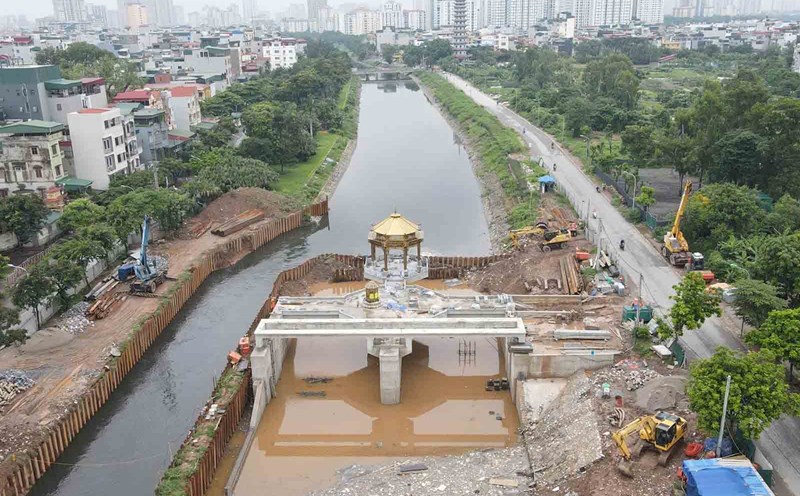The role of managing land price lists is needed from the central level
In a document sent to the Ministry of Finance to serve the meeting of the Steering Committee for Price Management in the second quarter of 2025, the Ministry of Agriculture and Environment (MONRE) said that the decentralization and delegation of authority in determining and deciding on land prices has initially been effective, contributing to the release of land resources and promoting the disbursement of public investment capital.
The Ministry of Natural Resources and Environment predicts that when localities simultaneously issue new land price lists according to the 2024 Land Law, land prices will have large fluctuations with different frontages between localities, causing many impacts on the market.
Commenting on this issue, Professor Dang Hung Vo - former Deputy Minister of Natural Resources and Environment (now the Ministry of Agriculture and Environment) - said that each locality can have a different approach in building a land price list, because this price list is regulated by the province.
However, he emphasized that the land price list cannot be "spermed" from one province to another, but in areas bordering provinces, there should be unified regulations.
"This province regulates a high land price list, the other province regulates a low level, which can easily lead to unreasonable differences, causing consequences and great impact on housing prices. Therefore, it is necessary to have management and review from the central level, in which the Ministry of Agriculture and Environment needs to be responsible for reviewing the land price list before the provinces approve it," he said.

According to Mr. Vo, the principle of building a land price list must still be consistent with the market. However, up to now, Vietnam has not yet had a document specifically regulating what is "market price", as well as no clear legal basis for land price determination techniques issued by the State. This is a big shortcoming, because "What to do to get market price" is a very important job.
Regarding the participation of the People's Committee at the commune level in the process of building the land price list, Mr. Vo said that commune officials are those who clearly understand the actual land price in the locality, because they regularly come into contact with people and land transactions.
However, the question is: What argument is used to determine that the price really reflects the market price? According to him, the story of determining market prices is a complex issue and requires a long roadmap.
In the context of not having enough legal basis, the current construction of land price lists is still mainly based on actual surveys in localities.
However, Mr. Vo noted that ministries need to play an inspection role, considering whether these price lists are reasonable and close to reality or not. Because if the approved land price list is lower than the market price, it will lead to many negative consequences, typically the fact that some subjects allocated land can take advantage of price differences for profit.
The land price list needs to ensure harmonious interests and stabilize the market
Dr. Pham Anh Tuan - Head of the Department of Land Management, Hanoi University of Natural Resources and Environment - said that when the People's Committees of provinces develop and adjust the land price list from now until the end of December 2025, the land price in the adjusted price list is expected to tend to increase compared to the current land price list. According to him, in the process of developing and issuing land price lists, localities need to pay special attention to some important points.
First of all, valuation must comply with the principle of being consistent with market land prices at the present time. The adjusted price list should not create a "shock" for land users, investors and the entire real estate market. The increase in land prices in the price list will benefit those whose land is reclaimed by the State, while contributing to increasing budget revenue from revenues such as land use fees, taxes and fees.
However, if the adjusted land price list increases, it will lead to an increase in investment costs in projects using land. The high cost of site clearance will increase the cost of real estate products, greatly affecting the output in the real estate market, both in the housing, commercial services, industrial and agricultural segments. This could also reduce competitive advantage in the context of Vietnam's efforts to attract foreign investment.
In addition, the increase in land prices in the price list also causes disadvantages for a part of the population when carrying out land-related procedures such as: granting a first land use right certificate, changing the purpose of use from agricultural land to non-agricultural land. In particular, converting from garden land (agricultural land in existing residential areas) to residential land will cause people to pay significantly higher land use fees.
To ensure the harmony in adjusting the land price list from now until the end of 2025, Dr. Pham Anh Tuan said that the Ministry of Agriculture and Environment and the Ministry of Finance need to coordinate in reviewing and studying the synchronous adjustment of financial policies related to land, including land use fees and land rents.
These policies need to be designed more flexibly, especially for foreign investors operating in areas and areas where the State is encouraging investment.
At the same time, it is necessary to clearly stipulate specific conditions for exemption and reduction of land use fees and land rents in cases where land use rights are recognized or land use purposes are allowed to be changed from agricultural to non-agricultural, as well as in housing development policies for low-income people...
The ultimate goal is for localities to build a land price list close to market price while still ensuring a harmonious balance of interests between the State, investors and land users. At the same time, it ensures the ability to attract foreign investment using land and promotes the stable and sustainable development of the real estate market.











